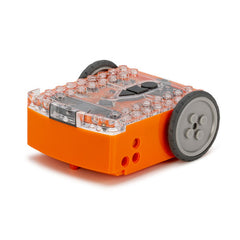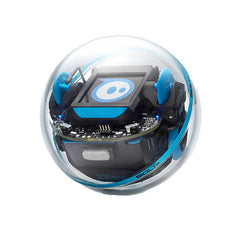It's the 21st century and you want your students to learn modern-day skills that will be useful for their future careers. Coding is by far one of the most important and highest in-demand skills of our age. It pays top dollar and guarantees you a job in almost any city around the world. But how can you make coding fun to learn for primary and secondary school students? The answer is of course... coding robots!
Why use robots in the classroom?
Coding robots provide a fun learning experience for students and an easy opportunity for educators to teach modern-day skills. Kids can code a robot and see their coding come to life! This is a fun approach to teaching something otherwise boring, and it allows kids to start learning coding from an early age.
Below we have summarised some of the key benefits of using robots in the classroom.
- Robots offer students hands-on learning in STEM (science, technology, engineering, and maths).
- Programming a robot teaches students how to think critically. Students will learn to break problems down into smaller chunks and then solve them by experimenting with different codes.
- Robots boost student engagement and help educators teach basic coding skills to young kids.
6 of the best robots on the market
Considering coding education, but having trouble picking the best robot? We have compiled a list of six of the best coding robots that are fun to use and effective at teaching programming skills. These robots require students to input code in order for the robot to perform a specific task. Doing so, kids can learn the basics of coding and understand the relationship between code and task.
Tale-Bot Pro
The Tale-Bot Pro is a small-wheeled robot best suited for early learners. Its simple design and limited number of components make it a great starting point for teaching coordination, directional language, and coding concepts. To make coding easy to learn, the Tale-Bot Pro uses a flat grid to represent its environment, which children can program to move around. This allows them to experience the basic concepts of programming and robotics in an easy and engaging way.
Some cool features to keep an eye on include object recognition and instant voice feedback, recording ability, and personalisation with multiple add-on accessories available.
VinciBot
The VinciBot is a great option for introducing coding to primary and secondary school children. This robot can be programmed using Scratch-based coding, Python coding, and Matatalab's very own MataCode app. Kids learn how to use code in a fun way by programming their VinciBot to complete tasks such as drawing patterns, following a track, or playing notes. The 8 in-built sensors allow for sound, light, and colour recognition, which can be used to set up a variety of different games.
Some features worth mentioning are the VinciBot's compatibility with LEGO bricks, which allows for more fun games to be played. This feature is especially good at helping students develop computational, design, and engineering thinking. The Matatalab VinciBot Robot also comes with three preset modes for quick and easy lessons:
- IR Remote Control Mode which allows students to control the robot's behaviour.
- Line Following Mode where the VinciBot automatically follows black lines on a map and reacts to different colours.
- Drawing Mode where the VinciBot autonomously draws preset patterns.
Ozobot Evo 18
The Ozobot Evo 18 is a more advanced robot which is best suited for children in the last years of primary school. This robotic toy opens the doors to coding with fun games that put kids' creativity to the test. You can program your Ozobot to race and even send signals with its array of LED lights. This allows students to get familiar with the different types of codes and how they affect the robot’s actions. To make things even better, the Ozobot website has a variety of resources for teachers, including lesson plans, activity suggestions, and a number of games that students can play with their robots – which makes implementing the robot into your teaching process even easier.
Some features worthy of our mention include remote control functionality, app-enabled (both iOS & Android compatible), and proximity sensing.
Edison Robot V2.0
The Edison Robot V2.0 stands out from the competition because of its compatibility with LEGO. Kids can customise their robots with LEGO bricks to make them unique. But let's not forget that the purpose is to teach them coding. The Edison Robot V2.0 uses fun games to introduce all sorts of programming concepts including sequential commands, branching, looping, conditional statements, functions, and arrays. These technical terms may sound intimidating, but the great thing about this robot toy is that it makes them fun and easy to learn.
Edison Robot offers three coding platforms: EdBlock for beginners, EdScratch for intermediate learners, and EdPy for advanced learners. These platforms are suitable for students in middle primary to upper secondary, and even in tertiary education.
Sphero BOLT
The Sphero BOLT is one of the most popular, if not the most popular programmable robot for the classroom. Because of its more advanced nature, the robot is best suited for older students nearing the end of primary school and is a fun way to learn coding through collaborative games. The Sphero BOLT offers the ability to learn to code by drawing, using Scratch blocks, or writing JavaScript text with the Sphero Edu app. This is a great introduction to key coding concepts that will place your kids ahead of the learning curve.
A couple of interesting features worth mentioning include a fully programmable LED matrix, a built-in compass that allows you to auto-aim your robot, and long battery life of 2+ hours. These features allow students to customise and control their Sphero BOLT with great precision, so they can make the most out of the coding exercises.
DJI RoboMaster
The DJI RoboMaster is the most advanced robot on this list and is best suited for children with previous coding robot experience. High school students can use their laptops to program the DJI RoboMaster to complete a wide range of advanced tasks with its robotic arm. The robot can even be integrated with AI platforms such as NVIDIA Jetson Nano and the official DJI SDK, giving the most advanced and all-around learning coding experience.
Noticeable features include:
- An intelligent controller that can simultaneously support functions including low-latency high-definition image transmission, AI computing, and programming development.
- Infrared distance sensor (range of 0.1-10 metres) that provides reliable distance measurement information for avoiding obstacles.






 MatataStudio Tale-Bot Pro Robot - $174.90 inc GST
MatataStudio Tale-Bot Pro Robot - $174.90 inc GST MatataStudio VinciBot Robot - $196.90 inc GST
MatataStudio VinciBot Robot - $196.90 inc GST Edison Robot V3 - $59.95 inc GST
Edison Robot V3 - $59.95 inc GST Sphero BOLT+ - $357.50 inc GST
Sphero BOLT+ - $357.50 inc GST






